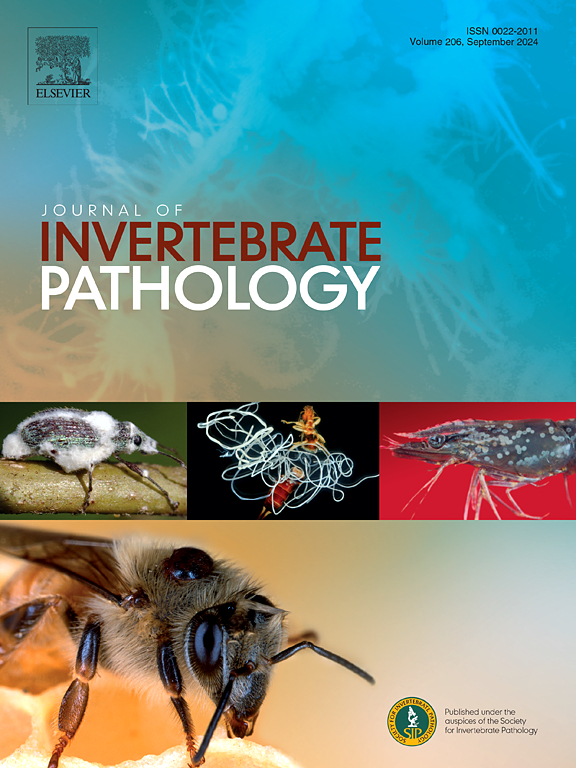Development of a Probe-Based quantitative PCR assay for detecting Nosema bombycis and its application in inspection and quarantine of silkworm egg production
IF 2.4
3区 生物学
Q1 ZOOLOGY
引用次数: 0
Abstract
Pébrine, a severe disease in sericulture, is caused by the microsporidium Nosema bombycis. As the pathogen can be transmitted through silkworm eggs, it is the only legally regulated quarantine target in silkworm egg production. Traditional detection methods rely on microscopic examination of female moths (female moth microscopy, FMM) and newly hatched larvae (Confirmatory microscopy), which are labor-intensive and prone to subjective interpretation. To address this, we developed a probe-based quantitative PCR (qPCR) method targeting the small-subunit ribosomal RNA (SSU rRNA) gene of N. bombycis. This method achieved a detection limit of 15 fg for N. bombycis genomic DNA and specifically identified microsporidia infecting silkworms, including N. bombycis and Vairimorpha necatrix BM, without cross-reactivity with other silkworm pathogens. With qPCR, N. bombycis can be detected in the midgut at 2 days post-infection (2 dpi), in the hemolymph at 3 dpi, and at 6 dpi in feces. The established qPCR was evaluated across 3616 samples of grandparent female moths, 2643 samples of parent female moths, and 1022 samples of first-generation hybrid (F1) newly hatched larvae. Comparing results with traditional microscopic inspection, concordance rates for positive samples were 93.82 %, 96.48 %, and 91.18 %, respectively, demonstrating a high level of agreement between the two methods; qPCR was able to detect 43.51 %, 58.95 %, and 2.13 % of suspicious samples, respectively, despite microscopic negative results, underscoring the superior sensitivity of qPCR over microscopic examination. Furthermore, qPCR enabled the direct detection of N. bombycis in F1 eggs, preventing the unnecessary elimination of 21.21 % of uninfected eggs that were misclassified by FMM. This highly sensitive and efficient method detects the pathogen 13–14 days earlier than traditional confirmatory microscopy in F1 newly hatched larvae without incubation and natural mortality. In conclusion, the probe-based qPCR method developed in this study exhibits high specificity, sensitivity, and accuracy, confirming its suitability for the detection of N. bombycis in silkworm egg production systems. This work offers solid data basis for qPCR application in the quarantine and inspection of N. bombycis, paving the way for more efficient and reliable molecular detection in sericulture.

基于探针的家蚕微孢子虫定量PCR检测方法的建立及其在蚕卵检验检疫中的应用
蚕桑病是蚕桑养殖中的一种严重疾病,由小孢子虫引起。由于该病原菌可通过蚕卵传播,因此是蚕卵生产中唯一受法律监管的检疫对象。传统的检测方法依赖于对雌蛾(FMM, female moth microscopy)和新孵化的幼虫(Confirmatory microscopy)进行显微镜检查,这是一种劳动密集型的方法,容易产生主观解释。为了解决这一问题,我们开发了一种针对家蚕小亚基核糖体RNA (SSU rRNA)基因的探针定量PCR (qPCR)方法。该方法对家蚕微孢子虫基因组DNA的检出限为15 fg,能够特异性鉴定家蚕微孢子虫,包括家蚕微孢子虫和家蚕微孢子虫,与其他家蚕病原菌无交叉反应。利用qPCR技术,可以在感染后2天(2 dpi)的中肠、3 dpi的血淋巴和6 dpi的粪便中检测到瓢虫。对3616份祖代雌蛾样本、2643份亲代雌蛾样本和1022份新孵化的第一代杂交(F1)幼虫样本进行了qPCR评价。与传统镜检结果比较,阳性样品的符合率分别为93.82%、96.48%和91.18%,两种方法的符合率较高;尽管镜检结果为阴性,但qPCR的检出率分别为43.51%、58.95%和2.13%,说明qPCR的灵敏度优于镜检。此外,qPCR能够在F1卵中直接检测到瓢虫,避免了被FMM错误分类的21.21%未感染卵的不必要清除。该方法在未孵化和自然死亡的F1新孵化幼虫中,比传统的验证性显微镜提前13-14天检测病原体,灵敏度高,效率高。综上所述,本研究建立的基于探针的qPCR方法具有较高的特异性、敏感性和准确性,适用于家蚕产卵系统中家蝇的检测。本研究为qPCR在家蚕检疫检验中的应用提供了坚实的数据基础,为蚕桑养殖中更高效、可靠的分子检测奠定了基础。
本文章由计算机程序翻译,如有差异,请以英文原文为准。
求助全文
约1分钟内获得全文
求助全文
来源期刊
CiteScore
6.10
自引率
5.90%
发文量
94
审稿时长
1 months
期刊介绍:
The Journal of Invertebrate Pathology presents original research articles and notes on the induction and pathogenesis of diseases of invertebrates, including the suppression of diseases in beneficial species, and the use of diseases in controlling undesirable species. In addition, the journal publishes the results of physiological, morphological, genetic, immunological and ecological studies as related to the etiologic agents of diseases of invertebrates.
The Journal of Invertebrate Pathology is the adopted journal of the Society for Invertebrate Pathology, and is available to SIP members at a special reduced price.

 求助内容:
求助内容: 应助结果提醒方式:
应助结果提醒方式:


